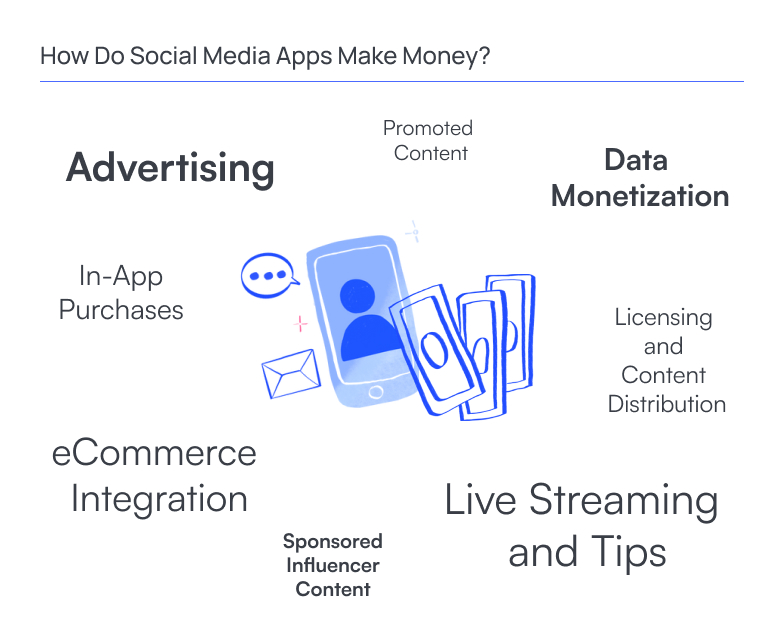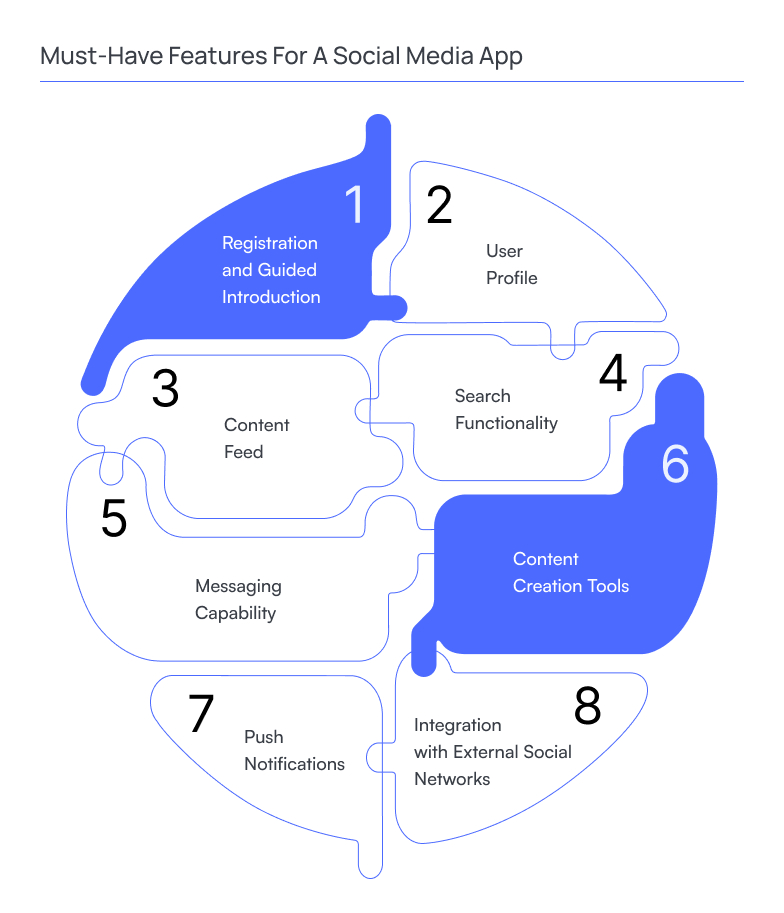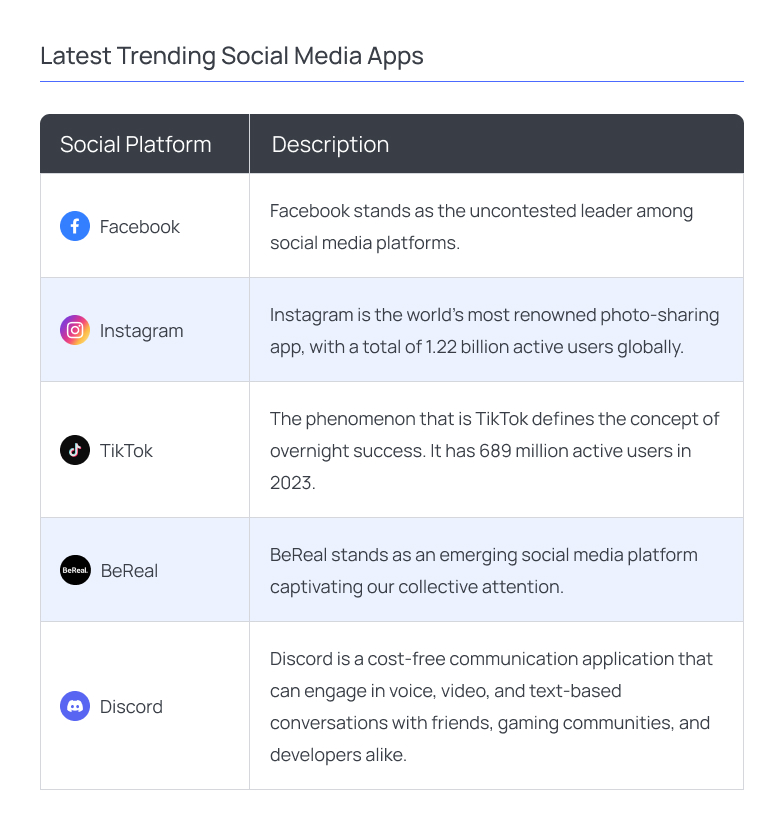Social media has become integral to our daily lives, reshaping how we
connect, communicate, and share information. From the pioneering days of Facebook to the rapid rise of newer platforms like TikTok and BeReal, the landscape of social media has undergone a remarkable transformation. Each year, these platforms continue redefining how we interact, influence, and engage with the world around us.
That is why many startup founders look for ideas and ways how to develop a social media app. So we’ll delve into every stage of development, from conceptualization and design to coding and deployment. We’ll navigate the critical decisions you’ll face, such as selecting the right features to foster engagement, ensuring security and privacy, and designing an intuitive user experience that captivates your audience. But it doesn’t stop there – we’ll explore monetization strategies, growth hacking techniques, and ways to keep your app relevant and vibrant as the digital landscape evolves.
Whether you’re crafting an app for like-minded enthusiasts, empowering professionals to connect, or reimagining the concept of digital socialization, this guide provides the blueprint to bring your vision to fruition. So let’s find out how to make a social networking app together.
How Do Social Media Apps Make Money?
How to start a social media app? The first thing to get started with is to create a business plan, paying particular attention to the business model your future app will follow to make money.

Fortunately, you don’t have to reinvent the wheel. You just have to analyze life-proven business models and choose the one that best suits your social startup idea. Below, we have reviewed four main business models for tech solutions and backed them up with the social media platforms examples.
Advertising
This is the primary revenue source for most social media platforms. They allow businesses and individuals to create targeted ads based on user demographics, interests, and behaviors. Advertisers pay the platform to display these ads to their desired audience. Platforms like Facebook, Instagram, Twitter, and TikTok rely heavily on advertising for revenue.
Promoted Content
In addition to traditional ads, platforms often offer the option for users and brands to promote their content to a larger audience. This includes sponsored posts, stories, and videos in users’ feeds or profiles.
Data Monetization
Social media platforms collect vast user data, including demographic information, interests, and online behavior. They can anonymize and aggregate this data to provide valuable insights to businesses, which can be used for targeted marketing, product development, and decision-making. Some platforms sell access to this data or offer advertising tools based on it.
In-App Purchases
Some social media apps, especially those focused on gaming or content creation, offer in-app purchases. Users can buy virtual goods, premium features, digital currency, or other enhancements to enhance their experience. Platforms like Snapchat and TikTok have integrated virtual goods and in-app purchases. By the way, we have an article on how to make an app like Snapchat, so check it out.
Subscription Models
Certain platforms offer premium subscription tiers that provide users with additional features, content, or an ad-free experience. For example, LinkedIn offers premium plans for professionals seeking enhanced networking and job-seeking features.
eCommerce Integration
Some platforms, like Instagram and Pinterest, have integrated eCommerce features that allow businesses to sell products directly within the app. Users can discover, browse, and purchase products without leaving the platform. Moreover, a world-known app like WhatsApp has even its WhatsApp Pay payment service integrated. And the app gets its fee for each transaction. So many business owners want to build a WhatsApp-like app
Live Streaming and Tips
Live streaming platforms such as Twitch and YouTube allow content creators to earn money through donations, tips, and subscription revenue from their viewers. Fans can contribute money directly to their favorite creators during live broadcasts.
Sponsored Influencer Content
Influencers with a substantial following can partner with brands to create sponsored content. They promote products or services to their audience, earning money in return. Platforms like Instagram and YouTube are popular for influencer marketing.
Licensing and Content Distribution
Platforms with user-generated content, such as YouTube and TikTok, might license user content to third parties or offer tools for content creators to monetize their creations. It can include options like allowing ads on videos or music tracks.
It’s important to note that the revenue models can vary depending on the specific platform, its features, and its target audience. You should consider it when you make your own social media app. Additionally, some platforms might use these strategies to maximize their revenue potential.
What Do Modern Users Expect From Social Media Platforms
If you want to create a social network app from scratch, you should know that you will work in a highly competitive environment. Modern users have a wide range of expectations from social media platforms due to evolving trends, changing user preferences, and technological advancements. Here are some of the users’ key expectations from modern social media platforms:

Mobile-friendliness. Since most social media traffic comes from mobile, there is a clear need to build a social media app with the mobile experience in mind.
Privacy and Data Protection
Users expect robust privacy controls and data protection mechanisms. They want to have control over what information they share, who can see their content, and how the platform and third parties use their data.
Customizable Feeds
Many users expect algorithms that curate their feeds based on interests and interactions. They want to see content that is relevant to them and avoid spammy or irrelevant posts.
Engaging and Authentic Content
Users value authentic, relatable, and engaging content. They want to connect with real people, see genuine stories, and interact with content that resonates with them emotionally.
Visual Appeal
Visual platforms like Instagram and TikTok need to prioritize aesthetics and high-quality visuals. Users expect visually appealing content and user-friendly interfaces.
Innovative Features
When building a social network website or app, it is crucial to remember that social media platforms must stay innovative by introducing new features and tools to enhance the user experience. Features like stories, live streaming, augmented reality filters, and short-form video content have gained popularity.
Minimal Ads and Intrusive Content
While ads are a source of revenue, users expect a balance between ads and organic content. They dislike intrusive ads that disrupt their experience.
Real-Time Updates
Users expect real-time updates on news, events, and their social circles. They want platforms to deliver timely information and connect them to the latest trends.
Cross-Platform Integration
Many users use multiple social media platforms. They expect seamless integration between different platforms and devices, allowing them to share content across various networks effortlessly.
Transparency
Users appreciate transparency in how content is promoted, algorithms work, and data is used. They want platforms to communicate openly about changes and policies.
Modern users expect social media platforms to prioritize their privacy, deliver relevant and engaging content, foster meaningful connections, and provide a safe and enjoyable online environment. Platforms meeting these expectations are more likely to retain and attract users.
Must-Have Features For A Social Media App
Social media applications cater to overlapping user groups, but each distinguishes itself through unique value propositions and purposes. For instance, TikTok caters to its fanbase through entertaining videos, while Instagram thrives among lifestyle influencers.

Despite these differences, several indispensable features should be present when you create your own social media app.
Registration and Guided Introduction
This feature enables users to register using various methods, including email and password, Facebook authentication, or phone registration. Additionally, most apps include an onboarding tutorial to guide users through the setup process after creating a new account.
User Profile
Reflecting its inherent social aspect, the application should furnish users with the space and tools to craft personalized profiles that showcase their individuality and dictate how they engage with the app’s content.
Content Feed
Users typically land in the content feed upon accessing the app. This feed is tailored to present users with content that aligns with their interests, ensuring an engaging and personalized experience.
Search Functionality
The search feature is a valuable tool for users to swiftly locate specific groups, content, individuals, and other pertinent information within the application.
Messaging Capability
Regardless of the app’s primary focus, having a messaging component is essential. A built-in chat messenger facilitates communication among users, allowing them to connect using text, voice messages, photos, or videos.
Content Creation Tools
The lifeblood of social media apps lies in user-generated content. It is imperative to provide users with comprehensive tools that empower them to share their experiences through text, images, or videos.
Push Notifications
Given the integration of social media into daily routines, push notifications play a pivotal role in notifying users about significant events like messages, reactions, and new content that might interest them.
Integration with External Social Networks
Since users often engage with multiple social media platforms, it’s beneficial for an application to integrate with third-party social networks seamlessly. This integration facilitates content sharing and fosters user growth.
In summary, regardless of the niche a social media app caters to, these core features are imperative to provide users with a seamless, engaging, and fulfilling experience.
How to Create a Social Media App in 8 Steps

1. Get Started By Doing an Ultimate Business Analysis
Skipping the business analysis stage is quite a crucial mistake in any solution development. This is just the process that allows for evaluating your idea, validating it taking market specifics and users’ preferences into account, matching it with your business development strategy, and finding the most innovative ways to create such a social platform that will solve a particular problem, make users engaged and drive profits. So business analysis is vital before creating a social network app.
2. Focus on Your Core Value and Match It With Your Business Model
Developing a value proposition for social media is challenging. There seems to be no opportunity to come up with something new when the App Store and Play Market are already teeming with social solutions of different kinds.
At this stage, you have to employ all the creativity you are capable of but be guided by the results of your business analysis. Such an ultimate approach will allow you to create a value proposition that will be swallowed by the market and match it with the business model that seems the most profitable.
3. Validate Your Idea One More Time
When you plan to build your own social network app, you must prove your concept first. Your Proof of Concept (POC) is a document that shows that your idea can be implemented in real life and will work in the way you expected. It also highlights the resources you need to develop your solution, the set of necessary tools, technologies, and talents, plus it may state the business feasibility of your startup.
Your Proof of Concept is crucial since it ensures no loopholes in your development strategy. Very often, it also reveals opportunities for additional improvement and allows you to avoid costly mistakes in the early development stages.
4. Develop Your First UI Design Prototype and Test It
After you are clear with the features set, look for ways to embed them into a convenient interface created according to the latest social media trends. By the way, analyze the trends in advance and don’t follow them mindlessly.
For example, Stories are quite trendy. Inspired by Instagram, they are already adopted by LinkedIn. But do they make sense in a professional networking platform? In a nutshell, ensure the trend you want to follow improves your UX and UI, and the corresponding feature is necessary, not only trendy.
After you are done, test your prototype with your users with the help of heat mapping and user acceptance testing.
5. Develop a Minimum Viable Product and Test It
Creating an MVP has never been as essential as it is with social media app development. The preferences of social media users and the trends they would like to follow are pretty difficult to predict. The only way to make some accurate predictions is to use AI, but your MVP is a tool to test the natural market environment and get a first-hand response. Still, you should prepare for unexpected results and be ready to use the gained insights at the next development stage.
6. Create a Marketing Strategy and Test It
Promoting a social media app is one more essential task you have to deal with. Popularizing social media with the help of other social media seems weird, so think about using different approaches. For example, get started with SEO-optimized content, partner with industry influencers, and run targeted ads.
But make sure to test each of your marketing approaches. In the world of social media, trends are changing too quickly, so the thing that worked yesterday may not work tomorrow.
7. Proceed With a Full-Fledged Social Media App Development
At this stage, you are almost done. The only thing remaining is to transform your MVP into a full-fledged application while keeping your users’ impressions in mind. At this point, some business owners tend to replace the development team, thinking that the major part of the job is already behind. However, proceeding with the same development team would be wiser since they are already deeply immersed in your business, plus it is always easier to continue working with the code created by your own hands.
8. Launch, Support, Maintain and Scale
After your social media is launched, prepare for the never-ending job of its support and maintenance. The more users you attract, the more effort your development team will have to put in to keep your solution working well.
Scaling your business also means scaling your UX, adjusting the working loads, localizing your product, and listening to your users’ opinions.
Technology Stack to Make a Social Media App
To find out what technologies and tools you need to make a social network app, let’s review what programming languages and frameworks are at the core of the most popular social platforms.
Python, Java, and Javascript are the most popular picks to make a social media app. We, at Binerals, may also suggest adding React and Relay for frontend development, plus Node.js and GraphQL for backend creation. However, the final choice will largely depend on your solution specifics, which will become clear after competent business analysis.
In addition to tools and technologies, you will also need experienced social media application developers. The perfect and effective team to build social applications will look as follows:
Business Analyst
Front-end and back-end developers
Designers
Quality Assurance
Specialists
Marketing specialists.
Such a winning combo of tech-savvy professionals with a social media creation experience will allow you to develop a top-notch solution demanded by the market and modern users.
We have them under our roof, so you are welcome to contact us for a free consultation.
Contact usHow Much Can It Cost to Build Own Social Media App?
As with any other solution development, the cost to create a social media app will largely depend on the technologies you choose, the complexity of your design, the number of features needed for an engaging interaction, and the location of your social network app development company. Creating your solution with the company’s help from top IT outsourcing destinations will allow you to significantly cut your cost while staying flexible and confident in the result.
However, choosing your development vendor may be challenging as well. We suggest partnering with those who are clear and transparent, especially when estimating your project development costs. Make sure they draw a clear line between the cost of creating an MVP and the cost of coming up with a full-fledged solution.
Estimating MVP development costs are quite real since, as a rule, it comes with quite a standardized set of features. Estimating the cost to create a complete solution is impossible primarily since the set of advanced features will be determined mainly by the market response and your users’ feedback after your MVP is tested.
Here is an approximate cost breakdown to create an MVP for a social media app.
Latest Trending Social Media Apps
Getting inspired by globally popular social media and analyzing their phenomena would also be the correct answer to how to make a social media app. We have outlined several industry-disrupting social platforms that are pretty trendy in 2023.

Facebook stands as the uncontested leader among social media platforms. Despite facing tumultuous early days and being associated with numerous controversies, its growth since its inception in 2004 has been astounding. Within ten months, Facebook amassed one million subscribers, and within eight years, it reached a staggering billion.
As of March 2023, Facebook proudly boasts a user base of 2.74 billion active users, with this number consistently growing by approximately 500,000 fresh users every day, equivalent to six newcomers every second.
Instagram is the world’s most renowned photo-sharing app, with a total of 1.22 billion active users globally. Conceived by Kevin Systrom, a former Google employee, in 2009, Instagram’s origin traces back to a meticulously detailed analysis of the prevailing social media landscape.
An initial seed funding round enabled Systrom to pivot the app’s focus from catering exclusively to whiskey and bourbon enthusiasts to a broader audience. This transformation brought forth pioneering image manipulation technology and an immersive social experience unmatched by other image-sharing services.
Among Instagram’s most enduring contributions to digital marketing is the inception of “influencers.” These individuals’ popularity lent their profiles an “aspirational” quality, sparking the emergence of an entirely new marketing channel that enabled regular individuals to capitalize on their popularity.
In addition, you can find out how to create your own app like Instagram, by reading our comprehensive guide.
TikTok
The phenomenon that is TikTok defines the concept of overnight success. It has 689 million active users in 2023. This video-sharing platform stormed onto the global stage in 2017 and swiftly amassed adoption figures that left competitors envious.
A mere two years after its introduction, TikTok had secured a place in the top five most downloaded apps worldwide. Within another year, it claimed the number one spot, and by a substantial margin. Outperforming its closest rival, WhatsApp, TikTok garnered 250 million more downloads.
And also recommend you pay attention to two social media apps that actively gain momentum in recent years: BeReal and Discord.
BeReal
BeReal stands as an emerging social media platform captivating our collective attention. Tailored for those who desire to share real-time photos and experiences, this platform, originating in France in 2019, dispatches daily notifications at random intervals. These prompts prompt users to simultaneously capture two photos: one with the front camera and the other with the rear camera. A two-minute window is allotted to capture a snapshot of the current activity.
Designating a team member each week to represent your brand on BeReal can yield significant dividends. This approach offers an excellent opportunity to capture behind-the-scenes content and provide insight into your brand’s operations. Preparing for the unexpected nature of BeReal’s photo prompts is pivotal to ensuring a coherent brand representation.
Discord
Discord is a cost-free communication application that can engage in voice, video, and text-based conversations with friends, gaming communities, and developers alike. With its expansive reach, encompassing hundreds of millions of users, Discord has firmly secured its position as one of the prevailing and sought-after methods for establishing online connections.
Established in 2015, Discord’s growth has been rapid in recent years. Its popularity within the gaming community stems from its user-friendly interface that seamlessly links multiple devices. It features channels akin to WhatsApp groups or Slack teams, serving as effective tools for organizing communities centered around topics such as video games or cryptocurrency.
Conclusion
As we come to the end of our exploration into how to build a social network website from scratch, we find ourselves standing on the threshold of an exciting and interconnected future. The journey you’ve undertaken, from the initial concept to the app’s deployment, has provided you with technical knowledge and positioned you as a force for change and meaningful interactions.
Remember, a successful social networking app is more than its features or coding process. It’s about the community it fosters and the value it brings to people’s lives. Your app holds the potential to bridge gaps, ignite collaborations, amplify voices, and redefine how we interact in the digital era.
Creating such an app, you need to always keep your finger on the pulse of the market and its trends, but remember the technical component. Our team can help with this challenging task by sharing and utilizing our experience in social network creation.
Build an app that has a lasting impact on how people communicate, collaborate, and build relationships online. Contact Binerals right now so we can assist in the development!
Contact BineralsFAQ
What are some essential features to include in a social networking app?
Key features include user profiles, registration, news feeds, chat/messaging capabilities, content sharing, search functionality, push notifications, and integration with external social apps. These elements form the foundation of a user-friendly and engaging app.
How do I monetize my social networking app?
Monetization strategies can include in-app advertising, premium subscriptions with enhanced features, data monetization, sponsored content, in-app purchasing, eCommerce integration, live streaming, or partnerships with brands and businesses. Choose a strategy that aligns with your app’s value proposition.
What are the steps of social network app development?
Suppose you plan to create a social media app. In that case, you must consider such 8 steps as detailed business analysis, choosing the right business model, idea validation, UI design prototype development, MVP development, marketing strategy creation, full-fledged app development, and launch with further support and maintenance.
